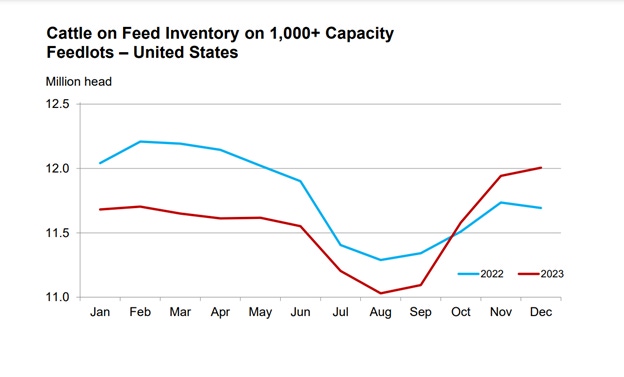Feedlot placements ‘finally’ below year-ago levels
Tighter supplies will mean even higher prices in the new year.

The U.S. feedlot inventory totaled 12.0 million head on December 1, 2023, a rise from December 1, 2022, USDA December “Cattle on Feed” report showed.
Oklahoma State University Extension livestock marketing specialist Derrell Peel noted that Texas (2.91 million head) and Kansas (2.50 million head) were up the most, with Texas up 4% and Kansas inventories up 7% year over year. Nebraska (2.58 million head) and Colorado (1.03 million head) were both down 1% compared to one year ago. Peel said these top four states represent 75.1% of December 1 feedlot inventories. Meanwhile, feedlot inventories in Iowa, which is the fifth-largest feedlot state, are up 2% at 640,000 head.
Considering what producers have been dealing with for the past year, a 2% year-over-year decline in feedlot placements in this month’s report was not unexpected, USDA livestock analyst Shayle Shagam said. Placements during November totaled 1.87 million head.
Net placements were 1.81 million head. During November, placements were 535,000 head for cattle and calves weighing less than 600 pounds, 440,000 head for 600-699 pounds, 380,000 head for 700-799 pounds, 288,000 head for 800-899 pounds, 140,000 head for 900-999 pounds and 85,000 head for 1,000 pounds and greater.
“Dry conditions, poor wheat pasture, tight water supplies likely pushed a lot of cattle in earlier than normally would have occurred,” he said. “As you sort of move forward, the supplies that are available for placement later decline.”
Peel said the overall placement total was a little larger than average expectations, at the top end of pre-report estimates.
“Although feedlot inventories are 2.7% larger than one year ago, total feedlot placements the last six months (which account for 96.2% of the December feedlot inventory), are down 0.3% from the same June-November period last year,” he said. “This means that the larger feedlot inventory now is due to a slower feedlot turnover rate and not because of increased total feedlot production.”
Marketings of fed cattle during November totaled 1.75 million head, 7% below 2022.
As for the markets, Peel said feeder and fed cattle prices increased the week before Christmas. The five-market cash fed price on December 22 was $170.50/cwt., up roughly $2.00/cwt. from the previous week.
“On a weekly basis, fed cattle prices have average 22% above year-earlier levels in 2023,” Peel noted.
During the final week of sales in 2023, feeder cattle prices were sharply higher in Oklahoma auctions. The price of 475-pound, medium/large, #1 steers was $317.52/cwt., up 44% from one year ago. These, Peel reported, have averaged 37% higher year over year across all weeks this year.
The price of 775-pound steers was $225.87/cwt., up 28% year over year. These big feeder cattle have averaged 31% higher year over year on a weekly basis in 2023, Peel added.
Looking ahead to 2024, Shagam said the tighter supplies will eventually mean even higher prices in the new year.
About the Author(s)
You May Also Like




.png?width=300&auto=webp&quality=80&disable=upscale)
